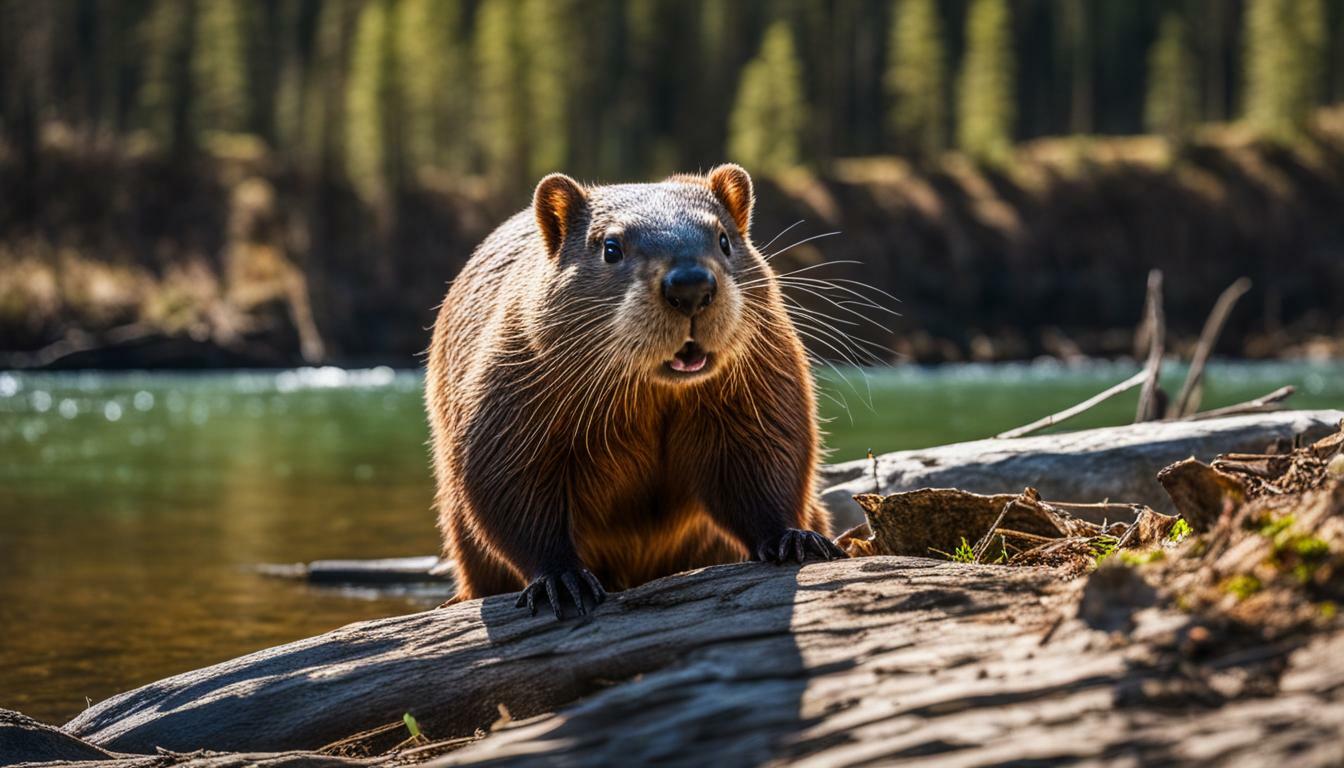If you’ve ever wondered whether beavers carry rabies, you’re not alone. Let’s delve into the facts and find out the truth.
Key Takeaways:
- Beavers can carry and spread the rabies virus, but they are not the primary carriers.
- Rabid beavers have been known to attack humans and domestic pets, resulting in injuries and fatalities.
- It is important to avoid interacting with wild beavers and report any encounters outside of their natural habitat to animal control authorities.
- Symptoms of rabies in beavers include aggression, difficulty eating or breathing, paralysis, seizures, and foaming at the mouth.
- If you encounter a beaver exhibiting these symptoms, it is crucial to seek professional assistance.
Understanding Rabies Transmission
To understand the risk of rabies in beavers, it’s important to consider their population, habitat, and behavior. Beavers are known for their ability to build intricate dams and lodges, creating habitats in wetland areas such as ponds, lakes, and rivers. These habitats provide ample sources of food, shelter, and protection for beavers.
Rabies, a viral disease that affects the nervous system, can be transmitted through the bite or scratch of an infected animal. While beavers themselves are not primary carriers of rabies, they can contract the disease if bitten by an infected animal like a raccoon or a bat. Once infected, beavers can then transmit the virus to other animals, including humans, through their bites.
Factors such as beaver population density, habitat size, and the availability of food and water sources can all influence the risk of rabies transmission among beavers. Additionally, beaver behavior, such as territoriality and the defense of their lodges, can increase the likelihood of interaction and potential exposure to the virus.
| Factors Affecting Rabies Transmission | Potential Impact on Beaver Population |
|---|---|
| High beaver population density | Increases the risk of virus transmission within the population |
| Larger beaver habitat | Reduces the likelihood of interaction with infected animals |
| Abundance of food and water sources | Promotes the overall health of the beaver population, reducing susceptibility to rabies |
| Territorial behavior and defense of lodges | Can lead to aggression and potential exposure to infected animals |
Understanding Rabies Transmission: Key Points
- Beavers can contract and transmit rabies through bites from infected animals.
- Population density, habitat size, and behavior can influence the risk of rabies transmission among beavers.
- Beaver habitats provide food, shelter, and protection, increasing the chances of encounters with infected animals.
By understanding the factors that contribute to rabies transmission among beavers, it is possible to take preventive measures and minimize the risk of rabies exposure for both humans and beavers. In the next section, we will explore the role of beavers as secondary carriers of rabies and the impact of the disease on their health.
Beavers as Secondary Rabies Carriers
While beavers are not primary carriers of rabies, they can still play a role in its transmission. Let’s examine how beavers can be affected by the virus and the signs to watch out for.
Beavers, like other mammals, can contract rabies if they come into contact with an infected animal. However, it is important to note that the prevalence of rabies in beavers is relatively low compared to other wildlife species. Nevertheless, when infected, beavers can transmit the virus to other animals, including humans and pets.
Recognizing the signs of rabies in beavers is crucial for identifying potential cases and taking appropriate action. Symptoms of rabies in beavers can include aggression, difficulty eating or breathing, paralysis, seizures, and foaming at the mouth. If you encounter a beaver exhibiting any of these symptoms, it is essential to seek professional assistance immediately.
| Signs of Rabies in Beavers | Actions to Take |
|---|---|
| Aggression | Keep a safe distance and avoid any interaction. |
| Difficulty eating or breathing | Contact local animal control authorities to report the sighting. |
| Paralysis | Do not attempt to handle the beaver yourself and notify professionals immediately. |
| Seizures | Avoid approaching the beaver and seek expert help as soon as possible. |
| Foaming at the mouth | Stay away from the beaver and inform the appropriate authorities. |
By understanding the signs of rabies in beavers and knowing what actions to take, you can help minimize the risk of transmission and protect both yourself and these remarkable creatures. Remember, prevention is key when it comes to rabies, so it is crucial to report any encounters with beavers exhibiting signs of the disease to animal control authorities. Together, we can ensure the well-being of both humans and beavers in our communities.
Risk of Beaver Attacks
Rabies can lead to aggressive behavior in beavers, increasing the risk of attacks on humans and pets. Let’s explore some instances of these encounters.
While beaver attacks on humans are relatively uncommon, there have been reported cases of rabid beavers attacking and causing injuries to people and domestic pets. In extreme cases, these attacks can result in fatalities. Beaver attacks usually occur when their territory is threatened or when they feel cornered or startled. It is important to remember that beavers are wild animals and should be treated with caution.
If you encounter a beaver in the wild, it is crucial to maintain a safe distance and avoid any attempts to approach or interact with the animal. Beavers are well-known for their powerful front teeth and can cause serious injuries when they feel threatened. It is recommended to keep pets on a leash and prevent them from getting too close to beavers, as this can provoke defensive behavior.
Instances of Beaver Attacks
| Date | Location | Description |
|---|---|---|
| July 2020 | State Park, ABC | A hiker was bitten by a rabid beaver while walking near a river. The hiker required medical attention and received rabies post-exposure treatment. |
| March 2019 | Residential Area, XYZ | A pet dog was attacked by a rabid beaver while playing near a pond. The dog suffered bite wounds and had to be treated by a veterinarian. |
| October 2018 | City Park, DEF | A child was scratched by a rabid beaver while trying to touch it near a creek. The child received medical attention and was monitored for potential rabies exposure. |
If you come across a beaver outside of its natural habitat, such as in a residential area or urban setting, it is important to report the encounter to your local animal control authorities. They will have the expertise to handle the situation and ensure the safety of both humans and the beavers themselves.
If you suspect a beaver may be infected with rabies, it is essential to seek professional assistance. Contact your local animal control agency, wildlife management department, or a wildlife rehabilitation center to report the animal’s behavior and provide them with all the necessary information. They will be equipped to assess the situation and take appropriate measures to protect public health and the well-being of the beavers.
Avoiding Beaver Interactions
To minimize the risk of contracting rabies from beavers, it’s crucial to know how to avoid interactions with these animals. Let’s explore some preventive measures.
1. Avoid approaching or disturbing beavers: Beavers are generally shy and prefer to keep their distance from humans. If you come across a beaver in its natural habitat, maintain a safe distance and avoid any sudden movements or loud noises that may startle or provoke them.
2. Do not feed beavers: Feeding beavers can disrupt their natural behavior and lead to increased interactions with humans. It can also create dependency and alter their feeding patterns. It’s best to let beavers forage for their own food.
3. Keep your pets on a leash: When walking your pets near beaver habitats, keep them on a leash and under control. Beavers may perceive them as a threat, which could lead to potential conflicts or attacks. By keeping your pets close, you can minimize the chances of encounters with potentially infected beavers.
| Preventive Measures | Impact |
|---|---|
| Avoid approaching or disturbing beavers | Minimizes the risk of provoking aggressive behavior |
| Do not feed beavers | Preserves their natural feeding patterns |
| Keep your pets on a leash | Reduces the chances of conflicts or attacks |
Note: While these preventive measures can help reduce the risk of interactions, it’s important to remember that beavers are wild animals and should be treated with caution. If you encounter a beaver that appears sick, exhibits aggressive behavior, or shows symptoms of rabies, it is essential to seek professional assistance. Contact your local animal control authorities for guidance on how to handle the situation.
Recognizing Symptoms of Rabies in Beavers
Recognizing the symptoms of rabies in beavers is key to understanding when they may pose a danger. Let’s explore the signs that suggest a beaver may be infected.
One of the most noticeable signs of rabies in beavers is a change in behavior. Rabid beavers may become unusually aggressive, attacking other animals or humans without provocation. This aggression can be accompanied by other symptoms such as difficulty eating or breathing, paralysis, seizures, and foaming at the mouth.
In addition to these behavioral changes, infected beavers may also exhibit physical symptoms. They may appear disoriented or uncoordinated, staggering or stumbling as they move. Their eyes may be dull or glassy, and they may have difficulty focusing or tracking movement.
| Signs of Rabies in Beavers |
|---|
| Aggression |
| Difficulty eating or breathing |
| Paralysis |
| Seizures |
| Foaming at the mouth |
| Disorientation |
| Staggering or stumbling |
| Dull or glassy eyes |
| Difficulty focusing or tracking movement |
If you encounter a beaver displaying these symptoms, it is essential to seek professional assistance. Contact your local animal control authorities, who can assess the situation and take appropriate action to protect both humans and the beaver.
Remember, wild animals should always be treated with caution, especially if there is a possibility of rabies. By recognizing the signs of rabies in beavers, you can help ensure your safety and the well-being of these important members of our ecosystem.
Section 7: Reporting Encounters Outside Natural Habitat
If you come across a beaver outside its natural habitat and suspect it may be infected with rabies, it’s essential to report the encounter to the appropriate authorities. Rabid beavers can pose a significant risk to both humans and pets, and taking prompt action is crucial to ensure public safety.
When reporting encounters with beavers, provide as much information as possible, including the location, date, and time of the sighting. Document any unusual behavior exhibited by the beaver, such as aggression, disorientation, or difficulty moving. This information can help animal control authorities assess the situation and take appropriate measures to mitigate the potential risks.
Remember, beavers are wild animals, and interactions with them should be avoided whenever possible. If you encounter a beaver in an urban or residential area, do not approach or attempt to handle it. Instead, keep a safe distance and immediately notify the relevant authorities. They will have the necessary expertise to handle the situation and protect both the public and the beaver.
Table: Contact Information for Reporting Beaver Encounters
| City/Region | Contact Number |
|---|---|
| City A | 555-1234 |
| City B | 555-5678 |
| City C | 555-9012 |
By reporting encounters with beavers outside their natural habitat, you play a crucial role in preventing the spread of rabies and safeguarding the well-being of your community. Be vigilant, stay informed, and take action if you suspect a beaver may be infected with this dangerous virus.
Seeking Professional Assistance
When faced with a beaver showing signs of rabies, it’s crucial to seek the help of professionals who can handle the situation safely. Rabies is a serious viral disease that affects the nervous system of mammals, including beavers. While beavers are not among the primary carriers of rabies, there have been reported cases of rabid beavers attacking humans and domestic pets, resulting in injuries and even fatalities.
If you come across a beaver exhibiting symptoms such as aggression, difficulty eating or breathing, paralysis, seizures, or foaming at the mouth, it is essential to avoid approaching or attempting to handle the animal yourself. Contact your local animal control authorities immediately to report the encounter and seek their guidance on how to proceed. These professionals have the necessary expertise and equipment to safely handle potentially rabid animals.
Animal control authorities will be able to assess the situation, capture the beaver if necessary, and arrange for appropriate testing to determine if it is indeed infected with rabies. They may also provide advice on preventing further contact with beavers and offer guidance on protecting yourself, your family, and your pets from potential rabies exposure.
| Signs of Rabies in Beavers |
|---|
| Aggression |
| Difficulty eating or breathing |
| Paralysis |
| Seizures |
| Foaming at the mouth |
Remember, your safety and the health and well-being of the beavers are of utmost importance. By seeking professional assistance, you can ensure that the situation is handled appropriately and minimize the risk of rabies transmission.
Beavers and Human Safety
Rabid beavers can pose a threat to human safety, and it’s important to be aware of the potential risks they may present. While beaver attacks on humans are relatively uncommon, there have been reported cases of rabid beavers attacking humans and domestic pets, resulting in injuries and even fatalities.
Beavers, like many other animals, can contract and spread the rabies virus. Although they are not among the primary carriers, they can still contribute to the transmission of the disease. When a beaver becomes infected with rabies, it may exhibit aggressive behavior and pose a danger to anyone who comes into contact with it.
To stay safe, it is crucial to avoid interactions with wild beavers, especially if they display any signs of unusual behavior. Symptoms of rabies in beavers can include aggression, difficulty eating or breathing, paralysis, seizures, and foaming at the mouth. If you encounter a beaver exhibiting these symptoms, it is essential to seek professional assistance immediately.
If you come across a beaver outside of its natural habitat, such as in residential areas or public spaces, it is important to report the sighting to animal control authorities. This helps ensure that appropriate measures can be taken to prevent the spread of rabies and ensure the safety of both humans and beavers. By working together as a community, we can help protect ourselves and these fascinating creatures.
Table: Tips for Staying Safe Around Beavers
| Tips |
|---|
| Avoid direct contact with wild beavers |
| Report any sightings of beavers outside their natural habitat to animal control authorities |
| Keep pets on a leash and away from beaver habitats |
| Do not provoke or disturb beavers in any way |
| Learn to recognize the symptoms of rabies in beavers |
| Seek professional assistance if you encounter a beaver exhibiting signs of rabies |
Beavers and Pet Safety
Rabid beavers can also pose a danger to our beloved pets. Let’s explore ways to protect our furry friends from potential encounters.
Beavers, although not the primary carriers of the rabies virus, have been known to exhibit aggressive behavior when infected. It is important to be aware of the risks and take necessary precautions to keep our pets safe.
Here are some tips to help protect your pets from encounters with potentially rabid beavers:
- Keep pets on a leash while walking near bodies of water or areas known to have beaver populations.
- Do not allow pets to swim or drink from ponds or streams where beavers are present.
- Ensure your backyard is securely fenced to prevent your pets from wandering into beaver habitats.
- Be cautious during dusk and dawn, as beavers are most active during these times.
If you suspect that your pet has been in contact with a rabid beaver, it is crucial to seek immediate veterinary attention. Symptoms of rabies in pets can include sudden aggression, excessive salivation, difficulty eating or drinking, paralysis, and seizures. Early detection and treatment can save your pet’s life.
| Symptoms of Rabies in Pets: | Preventive Measures: |
|---|---|
| Excessive salivation | Keep pets on a leash in beaver-prone areas |
| Sudden aggression | Securely fence your backyard to prevent access to beaver habitats |
| Difficulty eating or drinking | Avoid allowing pets to swim or drink from beaver-inhabited water sources |
| Paralysis | Be cautious during dawn and dusk, when beavers are most active |
| Seizures | Seek immediate veterinary attention if you suspect contact with a rabid beaver |
Beavers and Disease Prevention
Disease prevention is crucial when it comes to managing beaver populations and maintaining the health of ecosystems. Let’s explore the significance of controlling the spread of rabies in beavers.
Beavers can carry and spread the rabies virus, although they are not among the primary carriers. While cases of rabid beavers attacking humans are relatively uncommon, it is essential to be aware of the potential dangers. There have been reported instances of beaver attacks on humans and domestic pets, resulting in injuries and even fatalities.
Symptoms of rabies in beavers can include aggression, difficulty eating or breathing, paralysis, seizures, and foaming at the mouth. If you encounter a beaver exhibiting these symptoms, it is crucial to seek professional assistance immediately. This applies to both your safety and the well-being of the beaver.
To minimize the risk of encounters with potentially infected beavers, it is important to avoid interacting with wild beavers. Additionally, if you come across a beaver outside of its natural habitat, it is crucial to report the encounter to animal control authorities. By doing so, you can contribute to preventing the spread of rabies and ensuring public safety.
| Disease Prevention Tips |
|---|
| 1. Avoid interacting with wild beavers. |
| 2. Report beaver encounters outside of their natural habitat to animal control authorities. |
| 3. Seek professional assistance if encountering a beaver exhibiting symptoms of rabies. |
| 4. Educate yourself and others about the signs of rabies in beavers. |
| 5. Keep pets on leashes and minimize their exposure to areas with beaver populations. |
By following these disease prevention measures, we can help ensure the safety of both humans and beavers. It is vital to remember that beavers play an important role in maintaining the health of ecosystems, and by protecting them from diseases like rabies, we are contributing to the overall ecological balance.
Conclusion
By gaining a better understanding of how beavers can carry and transmit rabies, we can ensure our own safety and contribute to the overall well-being of these remarkable creatures.
Factual data shows that while beavers are not primary carriers of rabies, they can still carry and spread the virus. There have been reported cases of rabid beavers attacking humans and domestic pets, resulting in injuries and even fatalities. Although beaver attacks on humans are relatively uncommon, they can become aggressive when their territory is threatened.
It is crucial to avoid interacting with wild beavers and to report any encounters outside of their natural habitat to animal control authorities. This not only helps protect ourselves but also prevents the potential spread of rabies. Recognizing the symptoms of rabies in beavers, such as aggression, difficulty eating or breathing, paralysis, seizures, and foaming at the mouth, is essential.
If you come across a beaver exhibiting these symptoms, it is crucial to seek professional assistance. Contacting the appropriate authorities will ensure the safety of both humans and beavers. By responsibly intervening, we can help contain the spread of the virus and minimize the risk to ourselves and these incredible animals.
FAQ
Do beavers carry rabies?
Yes, beavers can carry and spread the rabies virus, although they are not among the primary carriers.
Are there cases of rabid beavers attacking humans and pets?
Yes, there have been reported cases of rabid beavers attacking humans and domestic pets, resulting in injuries and even fatalities.
How common are beaver attacks on humans?
While beaver attacks on humans are relatively uncommon, they can become aggressive when their territory is threatened.
What should I do if I encounter a beaver outside of their natural habitat?
It is important to avoid interacting with wild beavers and to report any encounters outside of their natural habitat to animal control authorities.
What are the symptoms of rabies in beavers?
Symptoms of rabies in beavers can include aggression, difficulty eating or breathing, paralysis, seizures, and foaming at the mouth.
What should I do if I encounter a beaver exhibiting symptoms of rabies?
It is essential to seek professional assistance if encountering a beaver exhibiting symptoms of rabies.
How can I stay safe around beavers?
To stay safe around beavers, it is important to avoid interactions, especially if their behavior is unusual or aggressive.
What should I do to protect my pets from rabid beavers?
To protect your pets from rabid beavers, keep them on a leash, avoid areas with beaver activity, and report any encounters to local authorities.
How can I help prevent the spread of rabies among beavers?
Reporting encounters with beavers outside their natural habitat and cooperating with animal control authorities can contribute to preventing the spread of rabies among beavers.
Are beavers a danger to humans and pets?
While beaver attacks on humans and pets are relatively rare, it is essential to be aware of the potential dangers they can pose, especially when rabies is involved.
How can I minimize the chances of encountering a rabid beaver?
Minimize the chances of encountering a rabid beaver by avoiding areas with beaver activity, keeping a safe distance, and being alert to any signs of unusual behavior.




